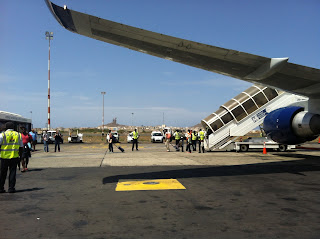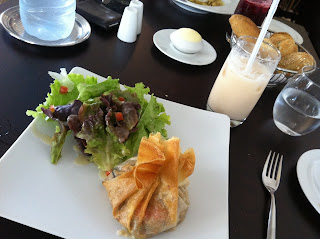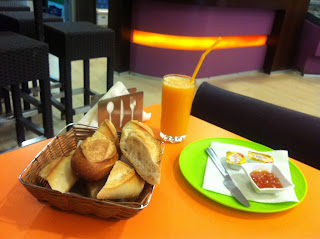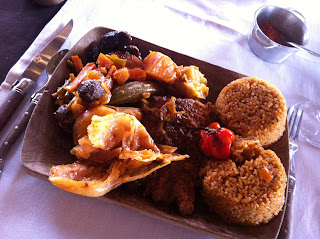I forgot that it was the 4th of July, since it is not celebrated here. Next weekend will be the beginning of Ramadan, which is supposedly a completely different Senegal since everyone is fasting. When I was here last time, I was walking around the city one day (instead of being in the hospital) when the call to prayer sounded--perhaps around 3:00 pm. The government official that I had been trying to speak with excused himself, grabbed a carpet that was rolled up in the corner, and headed outside. When I followed, I saw hundreds of people, mostly men, with carpets tucked under their arms--like ornate yoga mats. There were areas in front of the mosque where people lay down their carpets in rows and sat on their knees, heads bowed. My interpreter had forgotten his carpet, so he had to ask someone if he could share theirs. Still thinking along the lines of yoga, I had asked whether he would have enough space with two people on one mat, but clearly you don't need as much room to pray.
Today we interviewed the parents of the 14 year old girl who had passed away. She had been very religious as well, and spent a good portion of her time praying. Her mother let us listen to some prayers that she had sung and recorded on her cell phone while she had been alive. It was a hard interview to do, and I feel like this time, more than last time, there is such a heavy pressure to make changes. When agreeing to do the film, they had said that even though their daughter passed away, they considered it a good thing to continue fighting against the thing that killed her. They agreed to participate in the film because they want to improve access to health care in Senegal, which is our goal too. Sometimes--many times actually--I'm afraid that the work will not have any result. I think improvements have already been made since our presence here last fall, but I wonder to what extent. Our project is on palliative care, but palliative care is not enough. There is a balance however, on what we are able to demand from the government. If we demand too much, they do not listen at all. By demanding too little however, I feel like we let down all of the patients, and even the doctors, that we interviewed.
How can one improve cancer care with so little resources? Palliative care is easy--it is cheap, and the training to administer symptom relief is not so complicated. Oncology however, presents far more challenges. While it is a palliative care report, I hope that it will help raise awareness, not only for the desperate need for cancer treatment in Senegal, but also in developing nations as a whole. So little attention is given to non-communicable disease, despite the fact that the world's most deadly killer is not war, or famine, or HIV/AIDS--it's cancer. Of the foreign aid that is directed towards health in Africa, less than 3% goes towards non-communicable disease. Cancer in adults is tragic, but cancer in children is just obscene.
Senegal needs palliative care, but it also needs chemotherapy, radiotherapy, and other forms of curative treatment. I've been trying to schedule meetings with government officials to discuss our findings and recommendations, which has proved to be more difficult than I imagined. Our topic is not controversial, yet I think there is still trepidation when a human rights NGO "needs to talk." One simply hung up on me as soon as I said who I was. I've been trying to emphasize that we are not trying to villainize them, rather we want to collaborate on how to improve access to care--by suggesting what models to follow, how to allocate resources, and policy adjustments that make it easier for patients and hospitals to obtain medication.
Perhaps we will just have to spend the days sitting outside their office--or rather in front of their car so we can't get kicked out by security--until they listen to what we have to say. And even then, maybe our words will just fall on deaf ears. I hope it won't come to that.






